Breeding for balance
View Sequence overviewStudents will:
- explore the advantages and disadvantages of K-strategy reproduction.
- use a variety of data to identify the advantages and disadvantages of Antechinus agilis reproductive strategies.
Students will represent their understanding as they:
- use argumentation to discuss the advantages and disadvantages of Antechinus agilis reproductive strategies.
In this lesson, assessment is formative.
Feedback might focus on:
- the identification of the advantages and disadvantages of K-strategy reproduction.
- the ability to link the number of offspring produced to the amount of parental care.
- the ability to provide evidence and reasoning to support their claims.
- the ability to identify gaps in conclusions.
- the ability to consider if areas of uncertainty could lead to a viable conclusion.
Whole class
Access to the internet and YouTube for videos
Breeding for balance Resource PowerPoint
Each group
Sticky notes
Alternative physical modelling activity
- Opaque paper bag
- 20-40 counters
- Permanent marker
Each student
Individual science notebook
Trapping antechinus Resource sheet
Lesson
Re-orient
Recall the previous lessons on the different types of reproductive strategies (r- and K-strategies) that are used by animals. Discuss the r-strategy used by the bogong moth to ensure its survival and the disadvantage of the many young being vulnerable to environmental factors when immature.
The Inquire phase allows students to cycle progressively and with increasing complexity through the key science ideas related to the core concepts. Each Inquire cycle is divided into three teaching and learning routines that allow students to systematically build their knowledge and skills in science and incorporate this into their current understanding of the world.
When designing a teaching sequence, it is important to consider the knowledge and skills that students will need in the final Act phase. Consider what the students already know and identify the steps that need to be taken to reach the level required. How could you facilitate students’ understanding at each step? What investigations could be designed to build the skills at each step?
Read more about using the LIA FrameworkIdentifying and constructing questions is the creative driver of the inquiry process. It allows students to explore what they know and how they know it. During the Inquire phase of the LIA Framework, the Question routine allows for past activities to be reviewed and to set the scene for the investigation that students will undertake. The use of effective questioning techniques can influence students’ view and interpretation of upcoming content, open them to exploration and link to their current interests and science capital.
When designing a teaching sequence, it is important to spend some time considering the mindset of students at the start of each Inquire phase. What do you want students to be thinking about, what do they already know and what is the best way for them to approach the task? What might tap into their curiosity?
Read more about using the LIA FrameworkReproductive survival
Compare the bogong moth reproductive r-strategy to the human K-strategy. Compare the number of offspring born, the level of care the young require, and how long until the young mature.
Pose the question: I wonder if other mammals are the same as humans?
Discuss the characteristics of mammals: skin with hair or fur, able to warm themselves/homeostasis, few young fed with milk.
(Slide 25 and 26) Introduce the Antechinus marsupial mouse (Antechinus agilis). Compare the differences between marsupials and other mammals: marsupials have a pouch to protect their immature offspring. Antechinus has a pouch-like flap of skin that covers the teats.
Watch Mating to death: the tough life of an antechinus (2:07).
Discuss how the survival of the species depends on the survival of the females and the babies in their pouch.
Pose the question: Is it an advantage or disadvantage to have a pouch-like structure?
Antechinus marsupial mouse
Antechinus are small, insectivorous marsupials native to Australia.
Antechinus are small, insectivorous marsupials native to Australia. Species range from 12 to 31 cm in length and weigh between 16 and 170 grams. Most Antechinus species are sexually dimorphic, with males being larger. They are primarily found in bushland, rainforests, and some grasslands along Australia's eastern coast, particularly the Great Dividing Range. These animals are mainly insectivorous but have a varied diet, including beetles, spiders, larvae, and occasionally small vertebrates when food is scarce. They are opportunistic feeders. Smaller species, in general, hunt in trees, and larger species forage on the ground.
Antechinus exhibit highly specialised reproductive strategies, with females undergoing a brief, synchronised mating season that typically occurs from July to September. This timing is triggered by changes in daylight length (photoperiod), which vary with species and location. In areas where multiple species coexist, each species responds to a different rate of photoperiod change, contributing to reproductive isolation and potentially sympatric speciation. Larger species tend to mate earlier in the season than smaller ones. Mating is intense and can last up to 12 hours, with litters often having multiple fathers. Uniquely, males experience a complete die-off after mating due to a surge in stress hormones that suppress the immune system. This allows them to invest all their energy into a single, intense reproductive period.
Females typically give birth once or twice in their lives and have a flap of skin instead of a full pouch, with the number of teats ranging from six to twelve. This teat number influences litter size and survival, as smaller litters are less taxing for mothers and more conducive to survival in stable climates. After about 90 to 100 days of development, young Antechinus become independent, with the young males dispersing from the nest to avoid inbreeding.
A. arktos and A. argentus are listed as endangered, with all Antechinus species facing major threats from habitat destruction and introduced animals. Deforestation removes the dense understorey and tree hollows essential for shelter and nesting. This makes Antechinus more susceptible to introduced predators like foxes and cats. Competition from invasive rats and mice, along with habitat trampling by pigs, cattle, and horses, further contributes to population decline. Increased bushfire intensity has destroyed vital vegetation and food sources. Additionally, climate change poses a growing threat due to changes in vegetation and reduced habitat.
Antechinus are small, insectivorous marsupials native to Australia. Species range from 12 to 31 cm in length and weigh between 16 and 170 grams. Most Antechinus species are sexually dimorphic, with males being larger. They are primarily found in bushland, rainforests, and some grasslands along Australia's eastern coast, particularly the Great Dividing Range. These animals are mainly insectivorous but have a varied diet, including beetles, spiders, larvae, and occasionally small vertebrates when food is scarce. They are opportunistic feeders. Smaller species, in general, hunt in trees, and larger species forage on the ground.
Antechinus exhibit highly specialised reproductive strategies, with females undergoing a brief, synchronised mating season that typically occurs from July to September. This timing is triggered by changes in daylight length (photoperiod), which vary with species and location. In areas where multiple species coexist, each species responds to a different rate of photoperiod change, contributing to reproductive isolation and potentially sympatric speciation. Larger species tend to mate earlier in the season than smaller ones. Mating is intense and can last up to 12 hours, with litters often having multiple fathers. Uniquely, males experience a complete die-off after mating due to a surge in stress hormones that suppress the immune system. This allows them to invest all their energy into a single, intense reproductive period.
Females typically give birth once or twice in their lives and have a flap of skin instead of a full pouch, with the number of teats ranging from six to twelve. This teat number influences litter size and survival, as smaller litters are less taxing for mothers and more conducive to survival in stable climates. After about 90 to 100 days of development, young Antechinus become independent, with the young males dispersing from the nest to avoid inbreeding.
A. arktos and A. argentus are listed as endangered, with all Antechinus species facing major threats from habitat destruction and introduced animals. Deforestation removes the dense understorey and tree hollows essential for shelter and nesting. This makes Antechinus more susceptible to introduced predators like foxes and cats. Competition from invasive rats and mice, along with habitat trampling by pigs, cattle, and horses, further contributes to population decline. Increased bushfire intensity has destroyed vital vegetation and food sources. Additionally, climate change poses a growing threat due to changes in vegetation and reduced habitat.
The Inquire phase allows students to cycle progressively and with increasing complexity through the key science ideas related to the core concepts. Each Inquire cycle is divided into three teaching and learning routines that allow students to systematically build their knowledge and skills in science and incorporate this into their current understanding of the world.
When designing a teaching sequence, it is important to consider the knowledge and skills that students will need in the final Act phase. Consider what the students already know and identify the steps that need to be taken to reach the level required. How could you facilitate students’ understanding at each step? What investigations could be designed to build the skills at each step?
Read more about using the LIA FrameworkThe Investigate routine provides students with an opportunity to explore the key ideas of science, to plan and conduct an investigation, and to gather and record data. The investigations are designed to systematically develop content knowledge and skills through increasingly complex processes of structured inquiry, guided inquiry and open inquiry approaches. Students are encouraged to process data to identify trends and patterns and link them to the real-world context of the teaching sequence.
When designing a teaching sequence, consider the diagnostic assessment (Launch phase) that identified the alternative conceptions that students held. Are there activities that challenge these ideas and provide openings for discussion? What content knowledge and skills do students need to be able to complete the final (Act phase) task? How could you systematically build these through the investigation routines? Are there opportunities to build students’ understanding and skills in the science inquiry processes through the successive investigations?
Read more about using the LIA FrameworkCalculating population density
✎ STUDENT NOTES: Brainstorm the advantages and disadvantages of having young in a pouch.
(Slide 27) Pose the question: Does the number of offspring make a difference to the survival of the Antechinus mouse?
Introduce the two types of Antechinus agilis. One has females with 6 teats (6T), and the other type has females with 10 teats (10T). These variations usually live in different areas and do not often interbreed.
✎ STUDENT NOTES: Hypothesise if the number of 6T females in an area would be the same or different from the number of 10T females in a different area that is the same size. Assume that the vegetation is consistent between the two areas.
(Slide 28) Provide students with a copy of the Trapping Antechinus Resource sheet. Discuss the trapping process: Elliott traps are spread 20 m apart over a set area for 3 nights. Mice are caught, tagged in a way that does not harm them, and re-released into the environment. An equation can be used to estimate the size of the population.
(Slide 29) The number of A. agilis in a population ($N$) in each area can be estimated using the equation:
$$N=\frac{M \times n}{m}$$
$M$ = number of individuals caught in the first sampling, marked, and then released
$n$ = total number of individuals caught in the second sampling
$m$ = number of marked individuals that were recaptured
- Do you think trapping mice for only three nights each season gives an accurate picture of their population? Why or why not?
- The scientists assumed that capturing more mice in a trap means that more mice are living in that area. What does it mean when you assume something?
- Is this assumption valid?
- What other factors could affect the number of mice that are captured in a trap?
✎ STUDENT NOTES: Calculate the number of A. agilis in each population and answer the discussion questions.
(Slide 30) Introduce the table showing the mean densities of male and female A. agilis. Establish the meaning of ‘mean density (ha)’: the average number of animals trapped/hectare. Discuss how the mean density of males in each population were similar. This suggests that any differences in number of A.agilis caught were due to the number of females present.
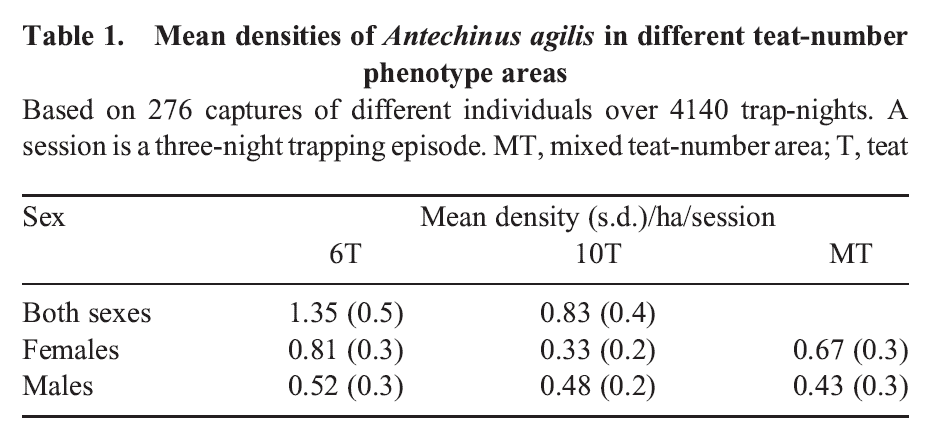
(Slide 31) Introduce the graph. Identify the data captured on each axis including the timing of each trapping session.
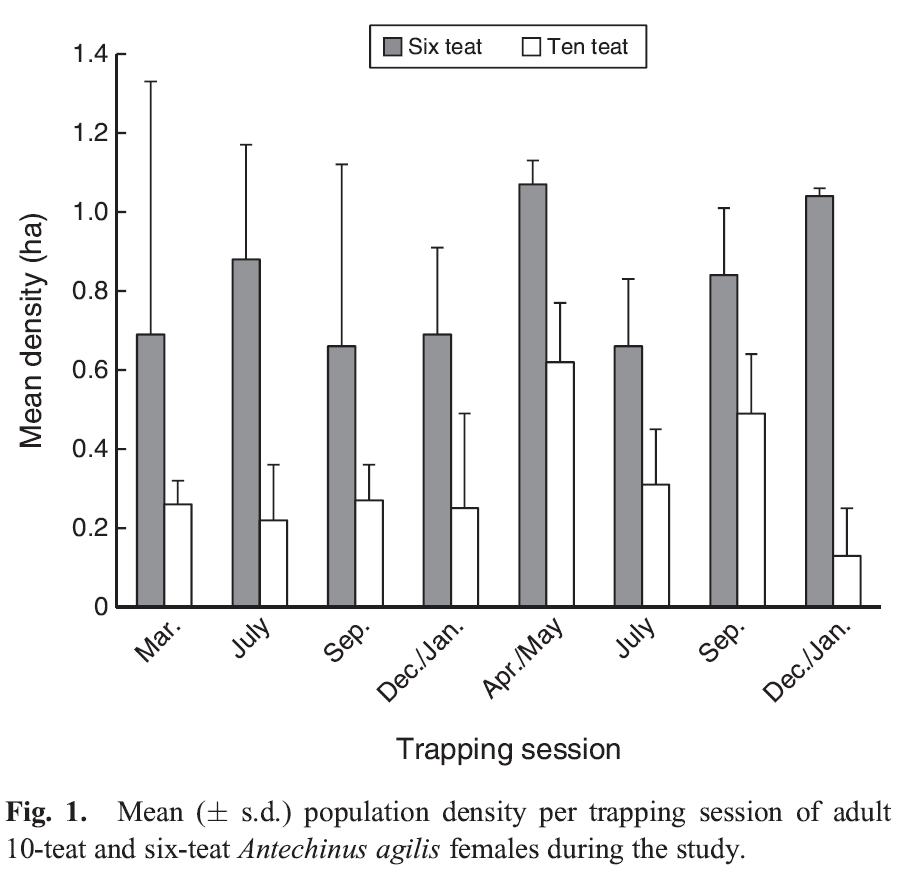
✎ STUDENT NOTES: Make a claim relating to the number of 6T or 10T females living in a hectare. Use data from the Trapping Antechinus Resource sheet or the graph from the scientists’ published data shown on slide 31. Identify the evidence that supports your claim and use reasoning to link the evidence to the claim.
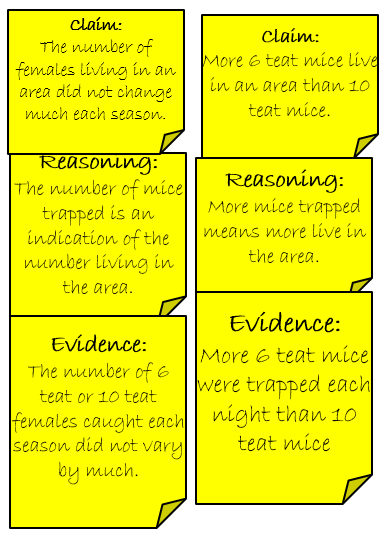
(Slide 32 and 33) Discuss the claims made by students. Students should be able to identify that there is a greater density of 6T than 10T Antechinus agilis. Encourage students to identify the qualifiers (i.e. ‘...for Antechinus agilis living in these areas...’), the backing (underlying assumption that the number of mice caught is an indication of the number living in the area), and a rebuttal to any opposing arguments that people might make.
- How many offspring could a female with 6 teats feed? What if they had more or fewer offspring?
- How do you think this would affect the mother’s ability to survive?
- Would it be easier or more difficult for the mother to survive if they had more offspring? Why or why not?
- What other explanations could there be for more females being caught in a trap?
- Could the 10T females be travelling further?
Pose the question: Could the 10T females be travelling further to find food?
(Slide 34) Introduce the data from Table 2 of the same article. Discuss how scientists placed radio transmitters on the individual A. agilis mice to measure how far they travelled in their search for food. Students should be able to identify that the 10T Antechinus agilis travel further to find food. Explore how the technology of radio transmitters has allowed scientists to understand more about how animals interact with their habitat.
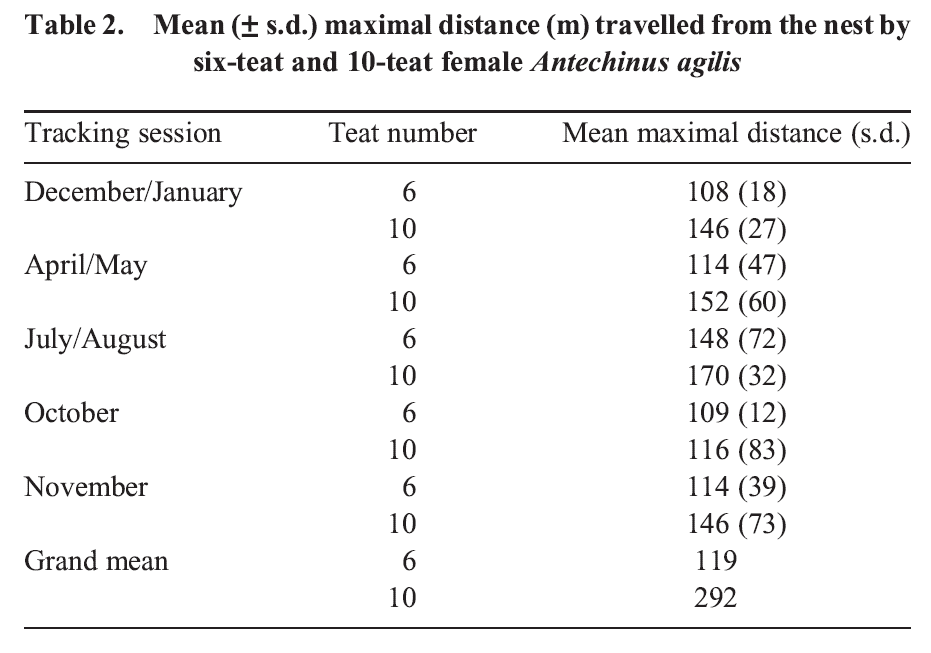
✎ STUDENT NOTES: Make a claim with evidence and reasoning from the data in Table 2 of the research paper.
Physical modelling alternative
Physical models are useful in helping students gain an understanding of processes or relationships in a scientific concept.
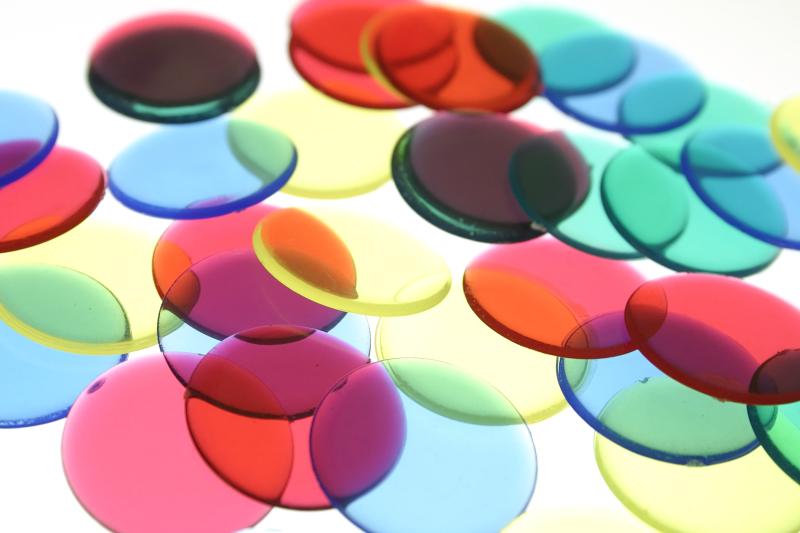
While the Trapping Antechinus Resource sheet provides data that accurately represents the data obtained by scientists, there is an opportunity for students to use a physical model of the capture-tag-recapture technique. Models are useful in helping students gain an understanding of processes or relationships in a scientific concept, but they should never be introduced without discussing their limitations. While the physical model below can be used to demonstrate the process used by the researchers studying Antechinus, the number of individuals in the studied population is too limited to make a physical model accurate or representative.
The physical model is outlined below.
1. Capture and Tag:
- A paper bag containing counters is used to represent the population of Antechinus.
- Students capture/select a sample of the counter and "tag" them (e.g. marking with a pen or using a different color).
- The number of tagged objects is recorded (M).
2. Release and Recapture:
- The tagged objects are returned to the bag and mixed thoroughly.
- A second sample is captured.
- The number of tagged objects in the second sample is recorded (m), as well as the total number of objects in the second sample (n).
3. Use the population equation to determine the total number of counters in the paper bag.
While the Trapping Antechinus Resource sheet provides data that accurately represents the data obtained by scientists, there is an opportunity for students to use a physical model of the capture-tag-recapture technique. Models are useful in helping students gain an understanding of processes or relationships in a scientific concept, but they should never be introduced without discussing their limitations. While the physical model below can be used to demonstrate the process used by the researchers studying Antechinus, the number of individuals in the studied population is too limited to make a physical model accurate or representative.
The physical model is outlined below.
1. Capture and Tag:
- A paper bag containing counters is used to represent the population of Antechinus.
- Students capture/select a sample of the counter and "tag" them (e.g. marking with a pen or using a different color).
- The number of tagged objects is recorded (M).
2. Release and Recapture:
- The tagged objects are returned to the bag and mixed thoroughly.
- A second sample is captured.
- The number of tagged objects in the second sample is recorded (m), as well as the total number of objects in the second sample (n).
3. Use the population equation to determine the total number of counters in the paper bag.
Standard deviations
Standard deviation is a statistical measure that indicates the amount of variation or dispersion in a set of data values.
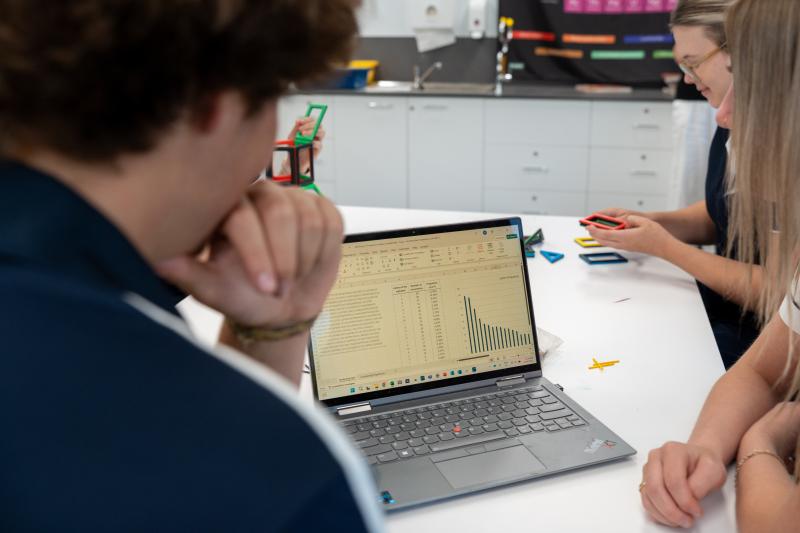
Standard deviation, as shown in Table 1, is a statistical measure that indicates the amount of variation or dispersion in a set of data values. A low standard deviation means most of the data points are close to the mean, while a high standard deviation indicates that the data points are spread out over a wider range.
.jpg)
Standard deviations are commonly used in data analysis to understand the consistency or variability of a dataset. For example, the mean density of 6T for both sexes is 1.35 (0.5). This means that most (68%) individual density values for this species tend to fall within 0.5 units above or below the mean—that is, between 0.85 and 1.85.
Standard deviation, as shown in Table 1, is a statistical measure that indicates the amount of variation or dispersion in a set of data values. A low standard deviation means most of the data points are close to the mean, while a high standard deviation indicates that the data points are spread out over a wider range.
.jpg)
Standard deviations are commonly used in data analysis to understand the consistency or variability of a dataset. For example, the mean density of 6T for both sexes is 1.35 (0.5). This means that most (68%) individual density values for this species tend to fall within 0.5 units above or below the mean—that is, between 0.85 and 1.85.
The Inquire phase allows students to cycle progressively and with increasing complexity through the key science ideas related to the core concepts. Each Inquire cycle is divided into three teaching and learning routines that allow students to systematically build their knowledge and skills in science and incorporate this into their current understanding of the world.
When designing a teaching sequence, it is important to consider the knowledge and skills that students will need in the final Act phase. Consider what the students already know and identify the steps that need to be taken to reach the level required. How could you facilitate students’ understanding at each step? What investigations could be designed to build the skills at each step?
Read more about using the LIA FrameworkFollowing an investigation, the Integrate routine provides time and space for data to be evaluated and insights to be synthesized. It reveals new insights, consolidates and refines representations, generalises context and broadens students’ perspectives. It allows student thinking to become visible and opens formative feedback opportunities. It may also lead to further questions being asked, allowing the Inquire phase to start again.
When designing a teaching sequence, consider the diagnostic assessment that was undertaken during the Launch phase. Consider if alternative conceptions could be used as a jumping off point to discussions. How could students represent their learning in a way that would support formative feedback opportunities? Could small summative assessment occur at different stages in the teaching sequence?
Read more about using the LIA FrameworkAll families great and small
Discuss the claims made by students. Encourage students to identify the qualifiers (i.e., "...for Antechinus agilis travelling the distances..."), the backing (underlying assumption of the accuracy of the transmitters and that the amount of vegetation in both areas is similar), and a rebuttal to any opposing arguments that people might make.
(Slide 35-36) Link the claims made by students to K-strategy reproduction by posing the question: Which mother (6T or 10T) is more likely to have all her offspring survive?
- Which mother is most likely to survive multiple breeding seasons?
- The 6T females are more likely to survive for 3 breeding seasons, while 10T females are less likely to survive. This is most likely due to the stress of finding enough food for all offspring.
- The offspring of which mother are most likely to survive?
- What are the disadvantages of K-strategy reproduction?
- What are the advantages of K-strategy reproduction?
- What would happen if the environment of the A. agilis were to change?
- A slow change may mean the parent has long enough time with the offspring to teach them how to survive. Alternatively, if the habitat is suddenly disrupted, all parents and their smaller number of offspring die.
(Slide 37) Discuss why scientists publish their results (containing claims) in scientific papers for peer review. Compare the peer review to the process of discussion that students just completed about the claims they made, and how this serves to check claims that are made.
✎ STUDENT NOTES: Outline the advantages and disadvantages of K-strategy reproduction for A. agilis.
Discuss how many offspring parents would need to produce to be classified as r-strategy.
- How many offspring is a lot? 10? 20?
- How long is ‘too long’ to take care of offspring?
- Can animals only use r-strategy or K-strategy reproduction? Could animals use a combination of strategies (e.g. a slightly larger number of offspring being looked after for a shorter length of time)?
Discuss the importance of understanding the reproduction strategies of an animal when identifying if an animal is endangered or threatened.
Reflect on the lesson
You might:
- research current conservation strategies being used for small mammals such as A. agilis.
- research ‘Bogong Bikkies’ and how they are being used to support the conservation of the Mountain pygmy possum.
- re-examine the intended learning goals for the lesson and consider how they were achieved.
- discuss how students were thinking and working like scientists during the lesson.